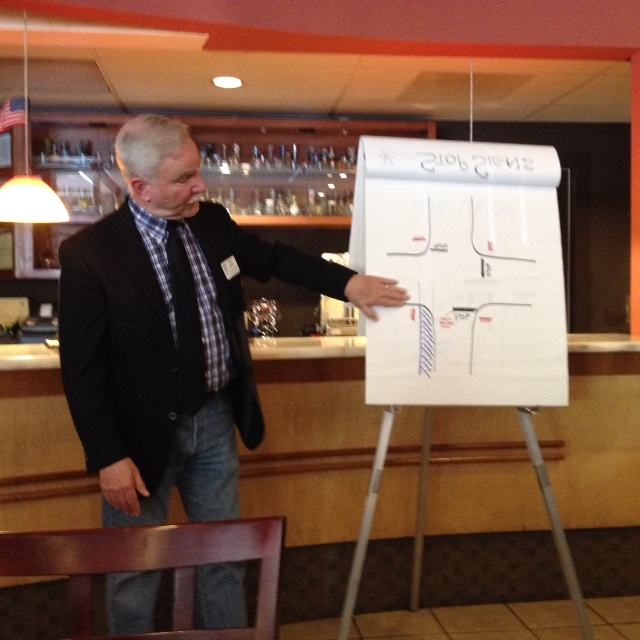TRAFFIC TICKET ? NO THANK YOU!

Our meeting on March 25 at La Piazza (thank you, Charles and staff!!) featured none other than our own Art Roth, who provided an informative and humorous dissertation on how to avoid the dreaded traffic citation.
Our California vehicle code consists of 18 divisions, 131 chapters and 42,277 sections – the highest number of traffic/vehicular laws in not only the United States, but in the world. There are 3 E’s to highway safety:
-
Education (i.e. Driver’s Ed)
-
Engineering (the design of highways and intersections
-
Enforcement (laws that govern how we conduct ourselves on the road)
Every road is essentially a highway with lanes – a typical road has two lanes , one in each direction. Lanes are numbered from the center outward.
On the standard 4-lane freeway, Lane #1 is called the MF lane (most fatal); Lane #4 – the furthest to the right – is the MD lane (most dangerous); Lane #3 is the AT lane (A-type trucker lane); and Lane #2 is considered the S Lane (safest lane). The CHP focuses on lane #1. Thus, to avoid being noticed, drivers should drive in any other lane –with preference to lane #2, as it is the safest lane in which to drive.
A business district consists of a strip of at least 600 ft. of businesses which front the street and is where U-turns are strictly forbidden. The crosswalk need not be painted on the roadway – it is merely an extension of the sidewalk according to the traffic code. A highway (again, any 2-lane road or larger is considered one) includes sidewalks, the shoulder and any center strips. The roadway is where the vehicles drive.
Ninety percent of traffic violations are for (in order of frequency):
-
Speeding
-
Not stopping at a stop sign or traffic light
-
Unsafe turns or not obeying signs to yield
-
UnlawfulU-turns where explicitly forbidden
-
Cell phone usage while driving
-
Not using seat belts
Traffic officers use different technologies and methods to track speeding: Radar, which can face to the front or back of the operator; LIDAR, which is laser based; pacing –in which an officer pulls alongside your vehicle; and PSE – perpendicular speed estimation. A “Duck Pond” is what the general public generally calls a speed trap. Over 80% of Duck Ponds are positioned to monitor downhill speeds. Likewise, 90% of Duck Pond monitoring is done from the right-hand side of the highway and around a right-leaning curve. Consequently, if you want to avoid a speeding ticket, consider slowing when the road heads downhill and curves to the right!
Officers typically allow some leeway with respect to speeding. You can always go 5 mph over and can generally get away with a 10-mph increase, but you are at risk when you exceed 15 or more mph greater than the posted speed. As for stop signs, train yourself to stop on the painted “S” at an intersection and you will never get a citation for running through a posted stop sign.
If you do happen see an officer on your tail, do NOT pull over unless you see his lights come on. Then wave to acknowledge that you see his request and pull over safely . Put the car in park, then lower your window all the way. Always be polite, always comply and NEVER admit to doing anything wrong! Instead of waiting for the officer to start talking, initiate the conversation with, “I know you stopped me for a good reason, but I thought I was doing everything right.” This makes the officer explain what you did wrong, instead of you.
Apologize, apologize, apologize! After the officer has told you the errors of your ways, humbly state, “Please accept my apology,” then continue the conversation with, “I’m so embarrassed…” The longer you talk or prolong your interaction with the officer, the more likely you are to avoid a ticket (note: for this reason, don’t hand over your proof of insurance right away – make this a separate hand-off from providing your license and registration. It means the officer has to spend more time with you).
Follow these simple rules and you will be less likely to ruin your (hopefully) perfect driving record!
